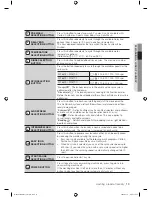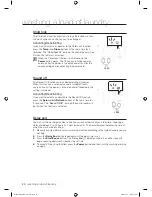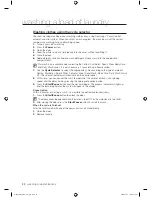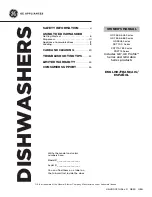
10_
setting up your new washing machine
setting up your washing
machine
MEETING INSTALLATION REQUIREMENTS
Electrical supply and grounding
To prevent unnecessary risk of fire, electrical shock, or personal injury, all wiring and grounding
must be done in accordance with the National Electrical Code ANSI/FNPA, No. 70 Latest
Revision and local codes and ordinances. It is the personal responsibility of the appliance owner
to provide adequate electrical service for this appliance.
Never use an extension cord.
Use only the power cord that comes with your washing machine.
When preparing for installation, ensure that your power supply offers:
•
220V~240V 50Hz 15 AMP fuse or circuit breaker
•
Individual branch circuit serving only your washing machine
Your washing machine must be grounded. If your washing machine malfunctions or breaks
down, grounding will reduce the risk of electric shock by providing a path of least resistance for
the electric current.
Your washing machine comes with a power cord having a three-prong grounding plug for use in
a properly installed and grounded outlet.
Never connect the ground wire to plastic plumbing lines, gas lines, or hot water pipes.
Improperly connecting the equipment-grounding conductor can result electrical shock.
Check with a qualified electrician or serviceman if you are unsure if the washing machine is
properly grounded. Do not modify the plug provided with the washing machine. If it does not fit
the outlet, have a proper outlet installed by a qualified electrician.
Water Supply
Your washing machine will fill properly when your water pressure is 50 kPa ~ 800 kPa. Water
pressure less than 50 kPa may cause water valve failure, not allowing the water valve to shut
off completely. Or, it may take the washing machine longer to fill than what the controls allow,
resulting in your washing machine turning off. (A fill-time limit, designed to prevent overflows/
flooding if an internal hose becomes loose, is built into the controls.)
The water taps must be within 4 feet (122cm) of the back of your washing machine for the
provided inlet hoses provided to reach your washing machine.
Most plumbing supply stores sell inlet hoses of various lengths up to 10 feet (305cm) long.
You can reduce the risk of leaks and water damage by:
• Making water taps easily accessible.
• Turning off taps when the washing machine is not in use.
• Periodically checking for leaks at water inlet hose fittings.
Before using your washing machine for the first time, check all connections at the water
valve and taps for leaks.
WARNING
WARNING
WF8804RS-02591C-01_EN.indd 10
2009-05-19 ¿ÀÈÄ 3:12:28











































